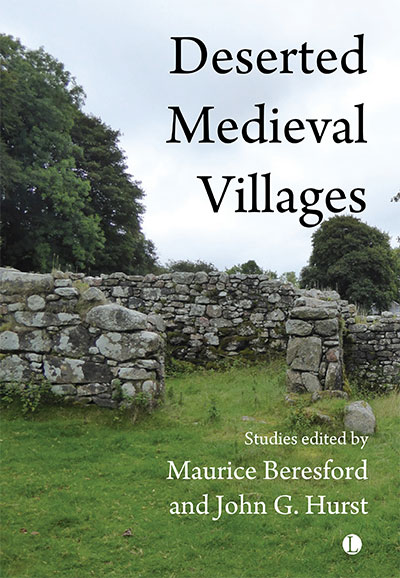Description
Deserted Medieval Villages combines archaeological and historical expertise to produce a comprehensive and detailed analysis of the studies of deserted medieval villages. Including an extensive historical and archaeological review of the surge in mid-20th century research, J.G. Hurst’s archaeological gazetteer of 290 sites, and analysis of Scottish, Welsh, and Irish sites, this book is an in-depth reference work.
Updating Beresford’s classic The Lost Medieval Villages of England, this book refreshes his historical research, considers the economic circumstances of desertion, and includes detailed maps, photographs and tables.
About the Author
Professor M. W. Beresford (1920-2005) had an abiding interest in the evidence of maps for reconstructing the appearance of the English countryside in the past, which led to several reference publications. He was also a Professor of Economic History in the University of Leeds, and the first Chairman of the School of Economic Studies.
J.G. Hurst (1927-2003) was the Inspector of Ancient Monuments for the Ministry of Public Building and Works, a founding member of the Society for Medieval Archaeology and President of the Society for Post-Medieval Archaeology.
Contents
Acknowledgments
List of Tables in the Text
List of Plates
List of Figures in the Text
Editors’ Introduction
Part One: England
1 A Review of Historical Research (to 1968) – M. W. Beresford, Professor of Economic History in the University of Leeds
Introduction
I: Early Desertion
II: The Black Death
III: Depopulation and Sheep
IV: Depopulation Arrested
V: Antecedents of Depopulation
VI: Vulnerability to Depopulation
VII: Village Sites after Desertion
VIII: Goldsmith’s Deserted Village
IX: Fieldwork and Site Quality
X: The Work of The Deserted Medieval Village Research Group
XI: Other Developments, 1954–68
Envoi: Beyond Britain
2 A Review of Archaeological Research (to 1968) – J. G. Hurst, Inspector of Ancient Monuments, Ministry of Public Building and Works
Introduction
I: Building Construction
II: Building Plans and Uses
III: The Changing Village Plan
IV: General Economic Development
3 Gazetteer of Excavations at Medieval House and Village Sites (to 1968) – J. G. Hurst
4 An Historian’s Appraisal of Archaeological Research – M. W. Beresford
Introduction
I: Dating
II: Changes in House Structure
III: Changes in Village Plans
IV: The Society for Medieval Archaeology
V: Personal
5 County Gazetteers of Deserted Medieval Villages (known in 1968) – Ed. Dr. J. Sheail, Scientific Officer, Nature Conservancy
6 Select Bibliography, England – Ed. J. G. Hurst
Part Two: Scotland
7 The Study of Deserted Medieval Settlements in Scotland (to 1968)
I Rural Settlement – H. Fairhurst, Department of Archaeology, University of Glasgow
II The Peasant-House – J. G. Dunbar, Royal Commission on the Ancient and Historical Monuments of Scotland
8 Select Bibliography, Scotland
Part Three: Wales
9 The Study of Deserted Medieval Settlements in Wales (to 1968) – Dr. L. A. S. Butler, Lecturer in Medieval Archaeology, University of Leeds
I: Historical Introduction
II: Excavation
10 I Gazetteer of Excavated Sites in Wales
II Select Bibliography
Part Four: Ireland
11 The Study of Deserted Medieval Settlements in Ireland (to 1968) – Dr. R. E. Glasscock, Lecturer in Geography, The Queen’s University, Belfast
I: Rural Settlement
II: The Peasant-House
12 I Gazetteer of Deserted Towns, Rural-Boroughs, and Nucleated Settlements in Ireland
II Select Bibliography
Appendices
I Memoranda on the Preservation of Deserted Medieval Village Sites
II Fieldwork Questionnaire
Index Mrs. A. F. Morley
Endorsements and Reviews
This handsome volume may be welcomed as the first major publication of the Deserted Me-dieval Village Research Group of which thetwo principal authors were founder members in 1952.
Colin Platt in The American Historical Review, Vol. 78, No. 2, 1973, pp. 416-417
There is no finality in the writing of history, least of all in so rapidly expanding a study as that of deserted villages. Future work will amplify without diminishing the permanent value of the information brought together in this fine book.
H.P.R. Finberg in Population Studies, Vol. 26, No. 2, July, 1972, p. 323
…,the book remains a land mark in British medieval settlement studies. It is attractively produced.
Lloyd R. Laing in The Scottish Historical Review, Vol. 51, No. 152, Part 2, October, 1972, pp. 202-204
This is a valuable and important book.
P.D.A. Harvey in History, Vol. 58, No. 194, 1973, pp. 437-439
They illustrate the close connection between archaeology, architectural history, historical geography and economic history which runs throughout the book and is the hall-mark of the Deserted Medieval Village Group.
R. H. C. Davis in The English Historical Review, Vol. 88, No. 349, October, 1973, pp. 886-887






